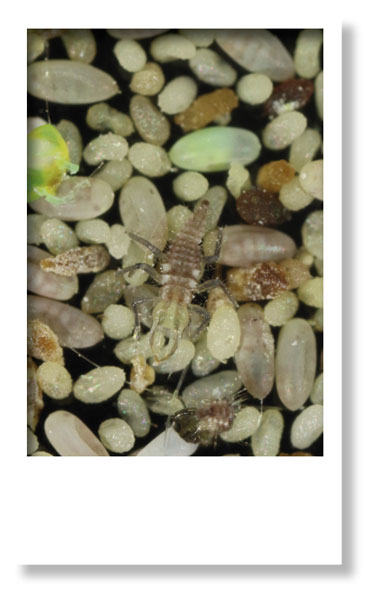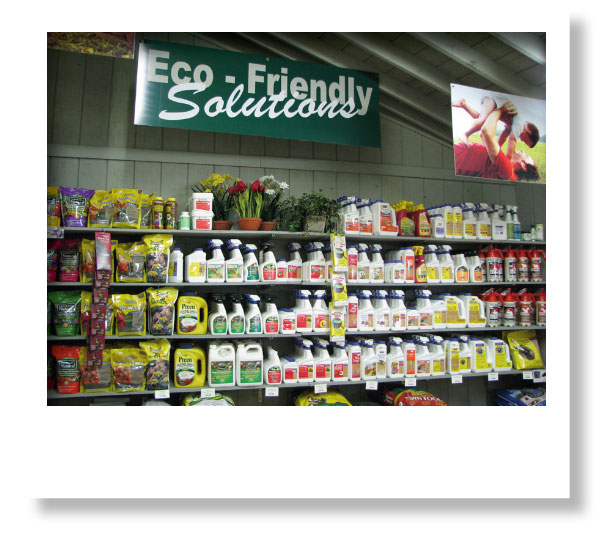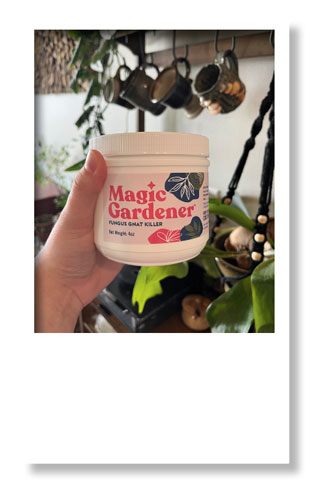3/28/2025
Bug Off!
Suzanne Wainwright-Evans

Garden centers face the dual challenge of managing pests in two key areas: controlling pests on the plants they sell and providing effective solutions for homeowners dealing with pests in their own gardens and houseplants.
Pictured right: Green lacewing egg cards are an excellent option for homeowners looking to manage various pests. They come in perforated strips that can be easily separated and hung on plants. While they don’t have the extended shelf life of conventional pesticides, they can be stored for a few days if kept at cool temperatures.
Dealing with pests on plants can be particularly challenging in a retail environment open to the public. Fortunately, horticultural oils and insecticidal soaps are effective for managing many common pest issues while also remaining user-friendly. These products typically lack strong odors and provide fast knockdown, making them suitable for public spaces—but they require contact with the pest, so good spray coverage is essential. Also, soaps and oils cannot be used on all types of plants, such as blue succulents.
Some garden centers still rely on systemic pesticides like imidacloprid and dinotefuran, which, when used properly, can be effective. However, they may act too slowly and many retailers have moved away from neonicotinoid use due to consumer concerns or potential risks to pollinators. Other registered options, such as insect growth regulators (IGRs), can be useful, but applying them in public spaces or managing restricted entry intervals (REIs) for employees can be challenging. In some cases, the most practical solution is to discard infested plants, as treatment may be too difficult, costly or risk spreading pests to other plants.

As an alternative to conventional pesticides, garden centers are integrating biological control methods into their plant care to manage pests such as aphids, twospotted spider mites, fungus gnats and others. These beneficial releases not only help control pests, but also serve as educational tools, allowing customers to learn about sustainable alternatives to traditional chemical treatments. It’s a great story to share on social media, attracting customers by demonstrating how beneficials work.
Pictured left: A newly hatched green lacewing larva from an egg card. They may be small, but they’re voracious predators, feeding on aphids, twospotted spider mites, mealybugs and other soft-bodied pests.
The second pest-related challenge garden centers face comes from homeowners seeking advice on dealing with pests in their home landscapes, lawns, vegetable gardens or houseplants. This requires employees to possess extensive knowledge of various plant species and pest management strategies. They must also understand pesticide labeling to recommend products that comply with regulations, while ensuring they’re easy to use, effective and affordable for customers. As many traditional pesticides (such as carbaryl, neonicotinoids and organophosphates) are being phased out, many customers are increasingly seeking eco-friendly, pollinator-safe alternatives.
Spray Products for Homeowners
Horticultural oils and insecticidal soaps may seem like old solutions, but they remain widely used for a few reasons. They’re affordable, environmentally friendly, have almost no risk of developing resistance and are easy to apply. Soap technology hasn’t changed much, but oils have. Thanks to modern refining processes and improved emulsification, oils are easier to work with these days. Additionally, some oils fall into the 25(b) minimum risk pesticide category, meaning they’re exempt from EPA registration. The advantage of using these products is that they require no REI or special personal protective equipment (PPE) for commercial spray applicators. Some of these oil products that were once exclusive to commercial growers are now available to homeowners, offering professional-grade pest management solutions.
One such product is GrowSafe from AgroMagen, a combination of soybean and corn oil that effectively controls mites and soft-bodied insects while safe for plants. Another innovative 25(b) minimum risk pesticide product is Epishield from BioWorks, a blend of essential oils with a light minty aroma (important in public spaces) that targets all life stages of twospotted spider mites. It also provides effective knockdown for pests like aphids and western flower thrips. Both of these products have commercial grower- and homeowner-sized packaging.
Pictured right: Calling out eco-friendly solutions gives customers a destination to head to for their control needs.
There are some new homeowner products that do not fall into the 25(b) minimum risk pesticide category and are registered with the EPA even though they’re softer microbial pesticides. The Magic Gardener line from Mycorrhizal Applications is one example. These products originate from Valent BioSciences Corporation, which has supplied microbial products to commercial growers for decades. Now through Mycorrhizal Applications, homeowners can access these commercial-grade solutions. The product line includes the biopesticide AmyloShield (Bacillus amyloliquefaciens, PTA-4838), Fungus Gnat Killer (Bacillus thuringiensis serotype israelensis), Caterpillar Control (Bacillus thuringiensis serotype kurstaki) and more products to come.
Beneficials for Homeowners
With homeowners investing in high-value plants, particularly tropical foliage, they’re more inclined to treat pests rather than discard their plants. Many home hobby growers have learned about biological control methods used in commercial production and are eager to adopt these pesticide-free alternatives. As a result, beneficial insects, predatory mites and beneficial nematodes are becoming increasingly popular among homeowners.
One innovative approach involves purchasing co-ops, where groups of homeowners collectively buy beneficial insects, shipped to one person and then members come pick up their beneficials. There are some very active groups that have used Facebook to organize. It’s proven successful in many cities and could be a strategy that retail garden centers might consider offering to their customers, as well.
Some bene ficial packaging is particularly well-suited for homeowners. For example, green lacewing eggs (Chrysoperla spp.) on cards have become extremely popular because they’re affordable and easy to use. The user can simply tear the strips apart and hang them on plants (indoor or outdoor). Once hatched, the lacewing larvae actively seek out and feed on soft-bodied pests like aphids, thrips, whitefly, spider mites and more. These are very popular with tropical foliage enthusiasts, as well as vegetable gardeners.
ficial packaging is particularly well-suited for homeowners. For example, green lacewing eggs (Chrysoperla spp.) on cards have become extremely popular because they’re affordable and easy to use. The user can simply tear the strips apart and hang them on plants (indoor or outdoor). Once hatched, the lacewing larvae actively seek out and feed on soft-bodied pests like aphids, thrips, whitefly, spider mites and more. These are very popular with tropical foliage enthusiasts, as well as vegetable gardeners.
Pictured left: Mycorrhizal Applications will be offering homeowners commercial-grade solutions with its new Magic Gardener line, including the biopesticide AmyloShield (Bacillus amyloliquefaciens, PTA-4838), Fungus Gnat Killer (Bacillus thuringiensis serotype israelensis), Caterpillar Control (Bacillus thuringiensis serotype kurstaki) and more.
Another popular solution is beneficial nematodes, which homeowners find easy to apply—simply mix them with water and apply to the soil. These are used to control fungus gnats, white grubs, fleas in lawns and other soil pests. Additionally, slow-release sachets commonly used in commercial production of hanging baskets and vegetable greenhouses are now being utilized in home settings. These sachets gradually release predatory mites over four to six weeks, providing long-term control for pests like thrips and twospotted spider mites. Purchasing co-ops order a box of sachets and then divide them amongst the members because most homeowners only need a few.
By offering commercial-quality pest management solutions that can easily be applied, garden centers can better serve their customers while promoting sustainable, effective alternatives to traditional pesticides.
Suzanne Wainwright-Evans is the owner of Buglady Consulting, providing pest management consulting services to the industry for over two decades. She can be reached at buglady@bugladyconsulting.com.
More on Two Key Bios
Bt (Bacillus thuringiensis) is a bacterium cultivated in commercial production facilities. Its spores and insecticidal toxins, known as Cry proteins, are harvested and formulated into pesticides. They’re applied to foliage or drenched into growing media. These products require ingestion by the target insect to be effective. Once consumed, the alkaline conditions in the insect’s gut activate the toxin, which then binds to specific midgut receptors. This interaction creates holes in the gut lining, leading to leakage of gut contents into the body cavity and ultimately causing the insect’s death.
Bt’s are very specific and each product will have its own “serotype”, like a cultivar. The most commonly used serotypes include Bt kurstaki and Bt aizawai for caterpillars, Bt israelensis for flies, and Bt tenebrionis for the Colorado potato beetle. Because each strain targets specific insects, Bt products are safe for pollinators and most beneficial insects.
Green lacewings are gaining popularity among commercial growers, farmers and homeowners alike—and for good reason. Their larvae are voracious predators, feeding on a wide range of soft-bodied pests, including aphids, whiteflies, mealybugs and thrips. Recent research from Purdue University high tunnel work highlights another advantage: lacewing larvae remain active in cool spring temperatures, feeding on pests when other beneficial insects are still inactive. As adults, green lacewings are pollinators, making them a valuable addition to home gardeners. GP